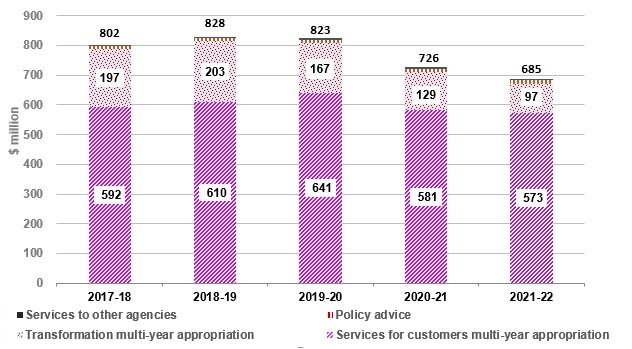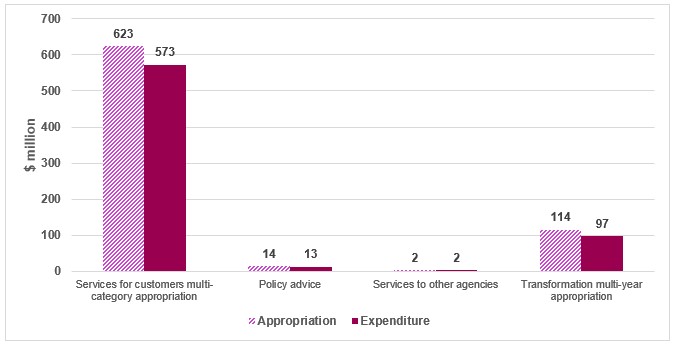Each year, we receive funding from the Government to deliver specific services. This funding is called an appropriation. An appropriation is a parliamentary authorisation for the Government or an Office of Parliament to incur expenses or capital expenditure. Expenditure can only be incurred under an appropriation or other statutory authority.
We were funded through 4 appropriations in 2021-22.
| Appropriation | Amount |
|---|---|
| Services for customers multi-category appropriation | $623 million |
| Transformation multi-year appropriation | $114 million |
| Policy advice | $14 million |
| Services to other agencies | $2 million |
Over the past 5 years, our total spend has decreased by $117 million as we transformed our organisation. Our total spend excluding the 'Transformation' appropriation has decreased by $17 million over the same period.
Operating expenditure from 2017-18 to 2021-22

We finished 2021-22 within all departmental appropriations.
In 2021-22, our total spend was $685 million, $68 million lower than our operating appropriations. The underspend of $17 million in the Transformation multi-year appropriation reflects further savings in the programme and will be returned to the Crown as part of our year-end surplus. Some of the remaining underspend in the Services for customers appropriation will form part of in-principle expense transfers from 2021-22 to 2022-23.
The lower spend in 2021-22 is mainly due to challenges in recruiting and retaining staff in the current labour market, underspending in compliance activities as our focus was on COVID-19 related initiatives, underspending in technology contracts and timing of expenditure for the administration of the Research and Development Tax Incentive scheme.
2021-22 expenditure against operationg appropriations

Our operating expenditure against appropriations including remeasurements (expenditure that does not require an appropriation) was $683 million. Operating funding of $35 million has been transferred to 2022-23 and 2023-24 from the Transformation multi-year appropriation to undertake residual transformation activities under the new 'Residual activities following the transformation programme's substantive closure' appropriation.
Our expenditure includes personnel, operating, depreciation and amortisation, and capital charge. Our total personnel costs for 2021-22 were $373 million. These costs were directly related to our people's remuneration, severance costs associated with transformation, employee entitlements and training and development costs. Operating costs for the year were $236 million. Approximately 94% of these operating costs relate to contractors, information technology, telecommunications, accommodation leases, consultants and office expenses.
Breakdown of expenditure by cost category
Capital expenditure is the purchase or development of assets by, and for the use of, Inland Revenue, as authorised by section 24(1) of the Public Finance Act 1989. We spent $35.6 million on capital investment in 2021-22. This was lower than our revised capital budget of $48.2 million, mainly due to a combination of accommodation fit-out savings, unused contingencies for the transformation programme and timing delays in the purchase of electric vehicles.
Our capital asset management priorities were as follows.
- Complete implementation of business transformation (target: 76% of total capital expenditure, actual: 74%)
Our capital investment for transformation included implementing core and supporting capabilities, including technology, for a modern, digital revenue system for New Zealand. The focus this year was the completion of the final stage of the transformation programme, including migrating the last of our major products (Child support) to the new START platform. - Maintain and improve business infrastructure (target: 24% of total capital expenditure, actual: 26%)
Our investment profile for maintaining and improving business infrastructure included technology replacement and accommodation fit-outs.
For details of departmental capital injections, refer to the 'Statement of departmental capital injections and capital withdrawals (2022)'. For details of departmental capital expenditure incurred against appropriations, refer to the 'Statement of departmental expenses and capital expenditure incurred without, or in excess of, appropriation or other authority (2022)'.
Statement of departmental capital injections and capital withdrawals (2022)
The Investor Confidence Rating is an assessment of the performance of investment-intensive agencies that manage investments and assets that are critical to the delivery of government services. Inland Revenue was last assessed in 2019.
The 2019 Investor Confidence Rating for Inland Revenue is A.
Having successfully achieved its outcomes and come in significantly under budget, the transformation programme was formally closed on 30 June 2022. From 1 July 2014 and up to the programme closure date, the transformation spend totalled $1.4 billion in capital and operating expenditure (excluding depreciation and capital charge).
Based on a 10-year business case view that also includes residual activities and incremental ongoing costs up to 30 June 2024, the final transformation capital and operating costs (excluding depreciation and capital charge) are expected to be about $1.6 billion. This has resulted in programme capital and operating (excluding depreciation and capital charge) funding savings of $266 million. Of these savings, $227 million was previously handed back to the Crown, $16 million is being handed back as part of the 2021-22 return of surplus and $23 million was previously repurposed by Cabinet for other priority spending in Inland Revenue.
Depreciation and capital charge savings of $214 million were also handed back to the Crown previously and a further $1 million is being handed back as part of the 2021-22 return of surplus. The total funding savings for capital, operating, depreciation and capital charge are $481 million.
We were able to self-fund 47% of the programme's capital and operating costs, achieving the business case target of a 40% to 50% funding contribution. We also self-funded around 90% of the depreciation and capital charge.
Operating expenditure for 2022-23 is forecast to be $747.4 million, an increase of $62.4 million from 2021-22. Capital expenditure for 2022-23 is forecast to be $52.7 million, an increase of $17.1 million from 2021-22. Our capital investment in 2021-22 was $35.6 million, contributing to the growth of our net assets. This was mostly driven by investing in intangible assets as part of our transformation.


